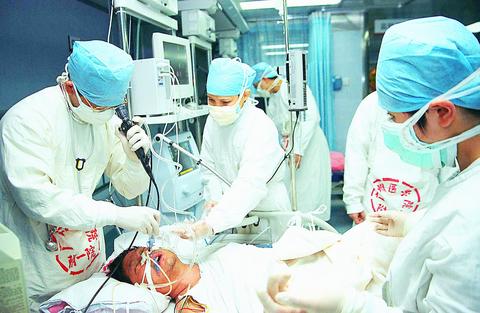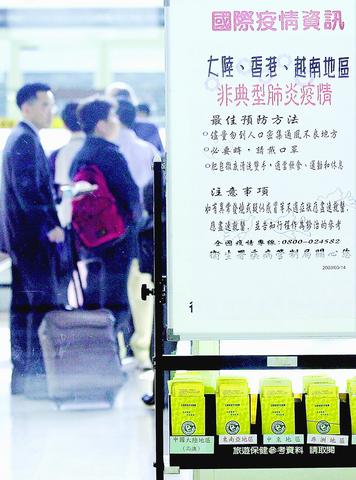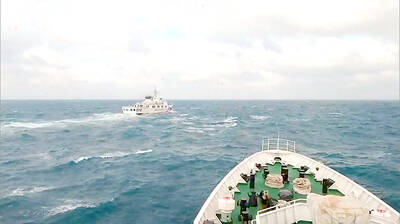The Mainland Affairs Council yesterday warned people planning to visit Hong Kong to be alert to the dangers of catching atypical pneumonia there, as a hospital in Taiwan treated a couple suspected of contracting the potentially deadly disease in Guangdong Province.
Chen Tzai-chin (
Chen said the couple's condition could not be confirmed until tests are completed on Monday.

PHOTO: AP
Chen declined to identify the couple, saying only that the businessman suffered symptoms similar to those of atypical pneumonia after coming back from Guangdong, and his wife's symptoms appeared after she began taking care of her husband.
Earlier yesterday council Vice Chairman Chen Ming-tong (
"We are hopeful that local citizens intending to travel to Hong Kong can steer clear of crowded and poorly ventilated public places and maintain vigilance regarding their own health and safety," Chen said, adding that officials will continue monitoring developments in the health situation in Hong Kong.

PHOTO: AFP
As many Taiwanese people often make pleasure trips to or transit stops in Hong Kong, staff members at CKS airport have stepped up a publicity campaign to remind Hong Kong-bound travelers of the new health hazard.
They distributed flyers and put up posters to inform outbound visitors of the atypical pneumonia alert.
The Department of Health issued a similar warning Thursday.
Taiwanese travelers who develop symptoms of pneumonia or flu after visiting Hong Kong or Vietnam should see a doctor immediately and list the places they have toured to facilitate diagnosis of their disease, the DOH said in a press release.
Many diseases, such as epidemic influenza and legionnaire's disease, can display symptoms of atypical pneumonia and should be treated carefully, the DOH press release said.

Auckland rang in 2026 with a downtown fireworks display launched from New Zealand’s tallest structure, Sky Tower, making it the first major city to greet the new year at a celebration dampened by rain, while crowds in Taipei braved the elements to watch Taipei 101’s display. South Pacific countries are the first to bid farewell to 2025. Clocks struck midnight in Auckland, with a population of 1.7 million, 18 hours before the famous ball was to drop in New York’s Times Square. The five-minute display involved 3,500 fireworks launched from the 240m Sky Tower. Smaller community events were canceled across New Zealand’s

The Ministry of Foreign Affairs (MOFA) yesterday said it is closely monitoring developments in Venezuela, and would continue to cooperate with democratic allies and work together for regional and global security, stability, and prosperity. The remarks came after the US on Saturday launched a series of airstrikes in Venezuela and kidnapped Venezuelan President Nicolas Maduro, who was later flown to New York along with his wife. The pair face US charges related to drug trafficking and alleged cooperation with gangs designated as terrorist organizations. Maduro has denied the allegations. The ministry said that it is closely monitoring the political and economic situation

‘SLICING METHOD’: In the event of a blockade, the China Coast Guard would intercept Taiwanese ships while its navy would seek to deter foreign intervention China’s military drills around Taiwan this week signaled potential strategies to cut the nation off from energy supplies and foreign military assistance, a US think tank report said. The Chinese People’s Liberation Army (PLA) conducted what it called “Justice Mission 2025” exercises from Monday to Tuesday in five maritime zones and airspace around Taiwan, calling them a warning to “Taiwanese independence” forces. In a report released on Wednesday, the Institute for the Study of War said the exercises effectively simulated blocking shipping routes to major port cities, including Kaohsiung, Keelung and Hualien. Taiwan would be highly vulnerable under such a blockade, because it

UNRELENTING: China attempted cyberattacks on Taiwan’s critical infrastructure 2.63 million times per day last year, up from 1.23 million in 2023, the NSB said China’s cyberarmy has long engaged in cyberattacks against Taiwan’s critical infrastructure, employing diverse and evolving tactics, the National Security Bureau (NSB) said yesterday, adding that cyberattacks on critical energy infrastructure last year increased 10-fold compared with the previous year. The NSB yesterday released a report titled Analysis on China’s Cyber Threats to Taiwan’s Critical Infrastructure in 2025, outlining the number of cyberattacks, major tactics and hacker groups. Taiwan’s national intelligence community identified a large number of cybersecurity incidents last year, the bureau said in a statement. China’s cyberarmy last year launched an average of 2.63 million intrusion attempts per day targeting Taiwan’s critical